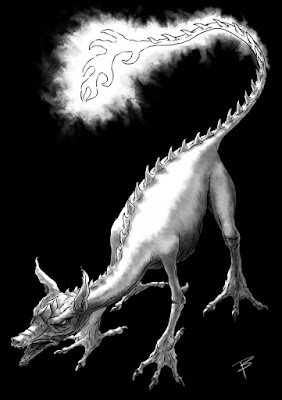This week I describe creatures that once figured quite strongly in English folklore, seemingly as some sort of physical representation of a wilder aspect of nature. They're mentioned, for example, in the Arthurian tale Sir Gawain and the Green Knight, but must predate that period by at least three or four centuries as their name seems to be of Anglo-Saxon origin. It's possible (at a bit of a stretch, in my opinion) that they are in some way related to the Green Man, a similarly mysterious figure who shares some aspects with the Woodwose. Lastly, the word 'Woodwose' works both as a singular and plural form.
WOODWOSE
FREQUENCY: Uncommon
NO. APPEARING: 2-6
ARMOR CLASS: 6
MOVE: 10"
HIT DICE: 2+2
% IN LAIR: 15%
TREASURE TYPE: V
NO. OF ATTACKS: 2 (clawed hands)
DAMAGE/ATTACK: By weapon or 1-8
SPECIAL ATTACKS: See below
SPECIAL DEFENSES: See below
MAGIC RESISTANCE: See below
INTELLIGENCE: Low to Average
ALIGNMENT: Neutral
SIZE: M
PSIONIC ABILITY: Nil
Attack/Defense Modes: Nil
Woodwose are only ever encountered in ancient woodlands or similarly remote and overgrown places, within which they are seldom seen unless they decide to make their presence felt. They are shy and timid creatures that will ordinarily go to great lengths to avoid any form of contact. They are dextrous and masters of camouflage and stealth, possessing abilities similar to Move Silently, Hide In Shadows and Climb Walls as if they were a 10th level thief.
Despite their timidity, they possess a curiosity that can override this aspect of their nature. When encountering parties of adventurers they will sometimes choose to follow them at a distance. Ordinarily they are terrified of fire and lightning, but should a party be engaged in cooking the woodwose might choose to break cover and approach, albeit haltingly. They seem to have a great interest in prepared food and the cooking of such things, but the sound of music also seems to have a similar attraction for them.
In combat their sharp, claw-like nails inflict 1-8 points of damage. There is a 50% chance that those encountered can also attack with poisoned darts. This poison is an insinuative B variety, the darts having a range of 20 feet and two may be thrown per turn. Otherwise they are armed with weapons equivalent to a club or quarterstaff.
All woodwose have the ability to cast Cure Light Wounds and Warp Wood
as a 3rd level druid. They are immune to cold attacks but fire and
lightning-based attacks will cause them to instantly flee. Their magic
and poison resistance allows them to save at 2 levels above their
actual. They possess excellent hearing and surprise on a roll of 1-4 on a
6-sided die, and see equally well by both day and night.
If encountered in their lair, there will always be one 4 HD individual, taller than the others and with hair entwined with a mass of thorny plants. It will know 1d6 druid spells in addition to those described above, casting them as a 4th level druid, and can (if threatened) summon 1d6 bears, wolves and similar creatures to its aid, which will arrive in 1-3 turns. They have no interest in treasure such as silver, gold, etc but seem to covet wands and staffs. These will be found within a giant ancient tree which stands at the centre of their lair. No woodwose children have ever been observed, and no-one knows how long they live. Some Elven folklore claims that when an old oak tree dies and collapses into ruin, woodwose spring up from the remains.
Woodwose speak their own language, which varies from growls to bird-like sounds. There is a remote chance (10%) that within any group encountered one individual will have a very basic knowledge of Common. However, Speak With Animals works just as well when communicating with them. If befriended or treated amiably, they will be happy to share information about recent and past events, as well as that pertaining to an area some 20 miles around them. Once per day they can accurately describe any location and on-going events within it up to a distance of 10 miles from where they stand. However, they may not understand all that they see and thus the information provided might be difficult to parse.
Description: Woodwose are tall and human-like in appearance, albeit with somewhat larger hands and feet. Aside from their hands and faces, their entire bodies are covered in thick hair that ranges in colour from black to light brown. This is covered in patches of leaves, lichen, moss and other plant material. The skin of their hands and face is dark reddish-brown and their nails are jet black. Their faces are their most striking feature, being wide and round with a pointed chin. Their eyes are large with no discernable pupils and resemble oddly reflective glass spheres. They have no teeth, but have a wide beak-like object within their mouths that is turquoise in colour.


















